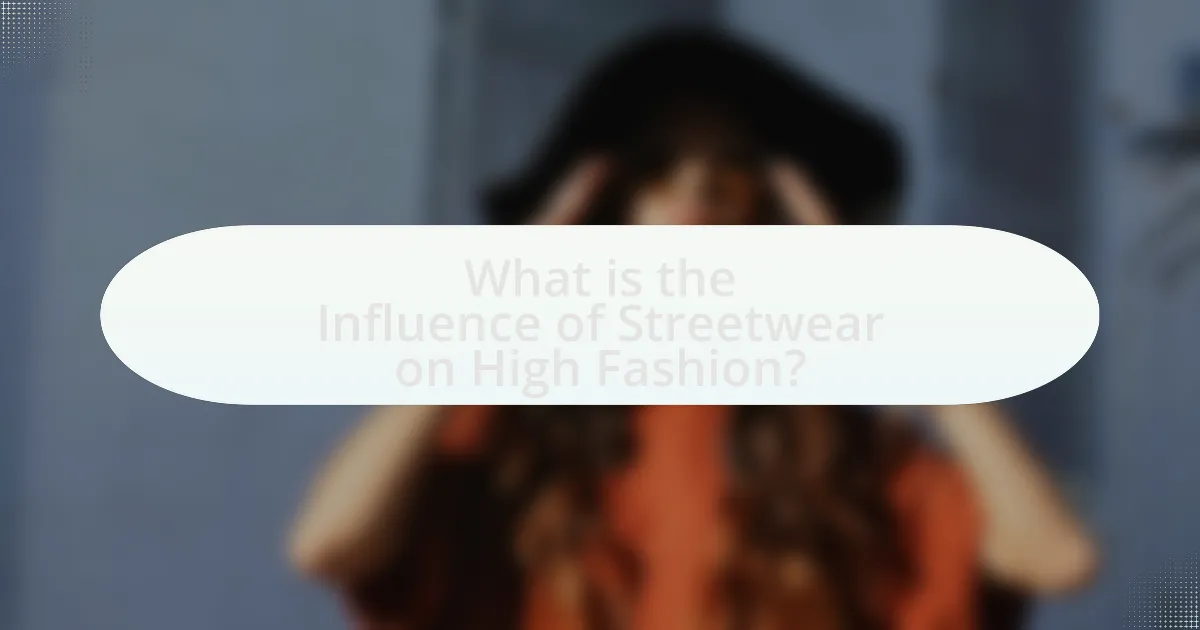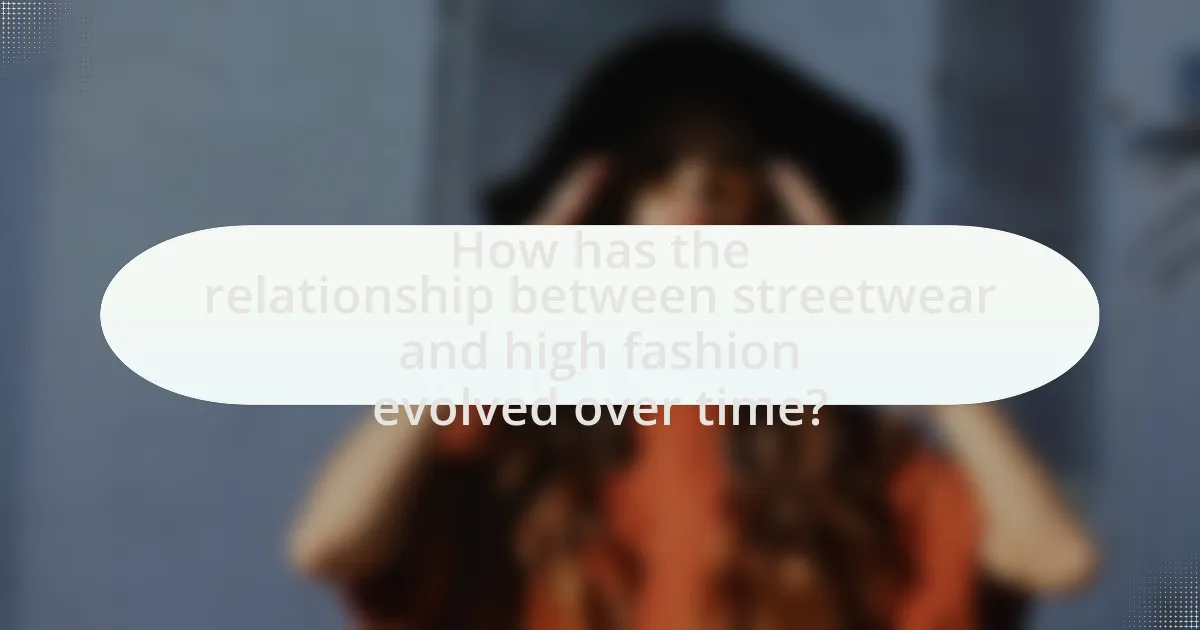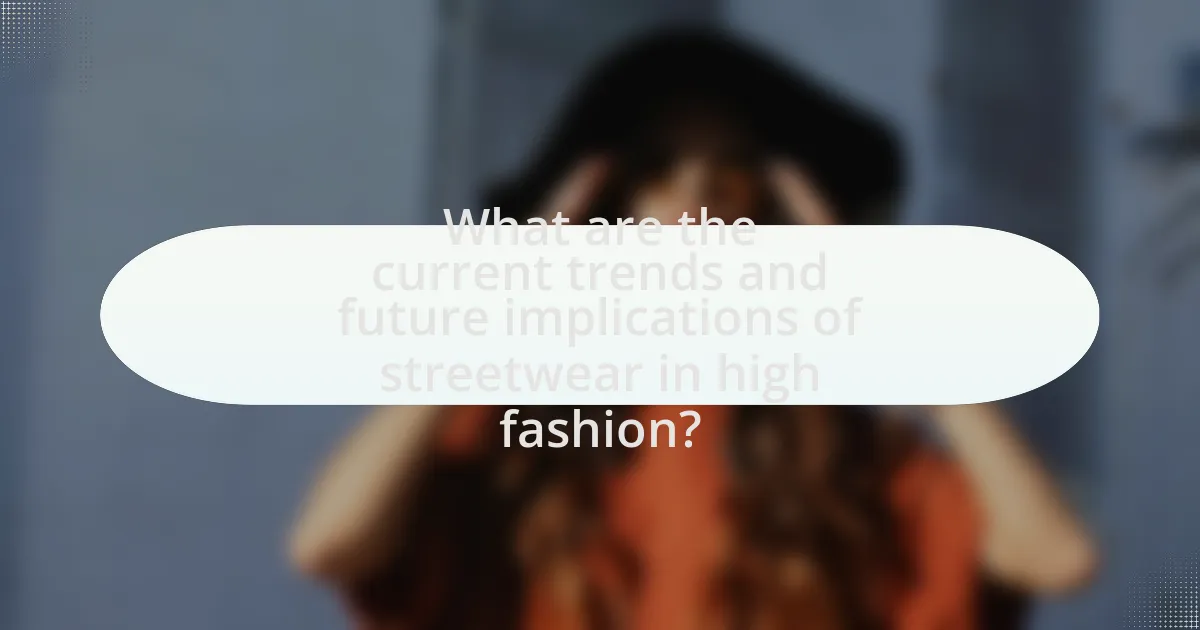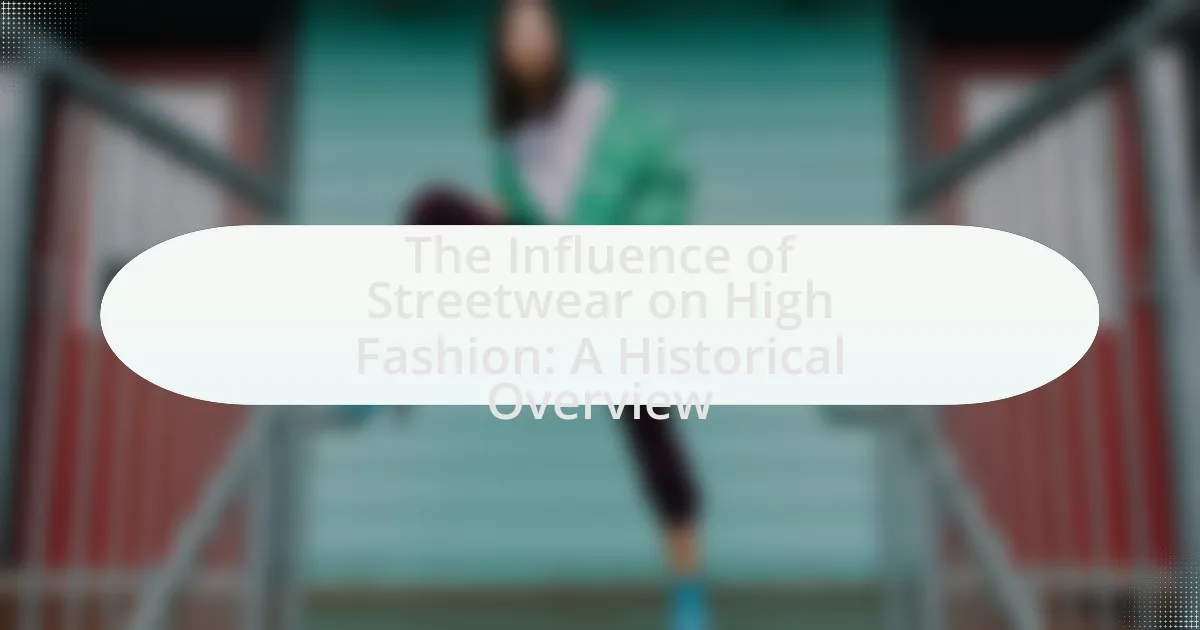The article examines the significant influence of streetwear on high fashion, tracing its evolution from a niche cultural movement to a dominant force in the luxury fashion industry. It highlights key milestones, such as the emergence of brands like Supreme and Off-White, and their collaborations with established luxury houses like Louis Vuitton and Gucci, which have redefined consumer perceptions and market dynamics. The discussion includes the origins of streetwear in urban culture, its disruptive characteristics, and the impact of social media on its rise, as well as current trends and future implications regarding sustainability and technology in fashion.

What is the Influence of Streetwear on High Fashion?
Streetwear has significantly influenced high fashion by introducing casual aesthetics, urban culture, and inclusivity into luxury design. This shift began in the late 20th century when brands like Supreme and Off-White blurred the lines between streetwear and high fashion, leading to collaborations with established luxury houses such as Louis Vuitton and Gucci. These partnerships not only elevated streetwear’s status but also allowed high fashion to reach a younger, more diverse audience, reflecting contemporary social movements and lifestyle changes. The integration of streetwear elements, such as graphic tees, sneakers, and oversized silhouettes, into high fashion collections has become a defining characteristic of modern luxury, showcasing the evolving nature of style and consumer preferences.
How did streetwear emerge as a significant cultural force?
Streetwear emerged as a significant cultural force through its roots in urban youth culture, particularly in the 1980s and 1990s, when it began to blend elements of skate, hip-hop, and punk fashion. This fusion was driven by influential brands like Stüssy and Supreme, which capitalized on the growing popularity of casual, comfortable clothing that resonated with the lifestyle of young people. The rise of streetwear was further propelled by the endorsement of celebrities and musicians, such as Kanye West and Pharrell Williams, who brought mainstream attention to the style. Additionally, the advent of social media platforms allowed for rapid dissemination and sharing of streetwear culture, enabling it to reach a global audience and solidify its status as a major influence in the fashion industry.
What are the origins of streetwear in urban culture?
Streetwear originated in the late 1970s and early 1980s as a fusion of skate culture, hip-hop, and punk influences within urban environments. This style emerged primarily in cities like New York and Los Angeles, where youth sought to express their identity and social status through casual, comfortable clothing. The rise of brands such as Stüssy and Supreme exemplified this movement, as they incorporated graphic designs and logos that resonated with the urban youth’s lifestyle. The cultural significance of streetwear is further evidenced by its adoption by influential figures in music and art, which helped to solidify its place in mainstream fashion.
How did streetwear evolve through the decades?
Streetwear evolved significantly through the decades, beginning in the late 1970s and early 1980s with influences from skate and hip-hop culture. In the 1990s, brands like Supreme and Stüssy emerged, popularizing graphic tees and baggy silhouettes, which reflected urban youth culture. The 2000s saw collaborations between streetwear and luxury brands, such as Louis Vuitton and Takashi Murakami, further blurring the lines between high fashion and street style. By the 2010s, streetwear became a dominant force in fashion, with designers like Virgil Abloh and brands like Off-White leading the charge, showcasing streetwear’s impact on mainstream fashion. This evolution illustrates how streetwear transitioned from niche subcultures to a significant influence on global fashion trends.
Why is streetwear considered a disruptive force in high fashion?
Streetwear is considered a disruptive force in high fashion because it challenges traditional fashion hierarchies and promotes inclusivity and accessibility. This genre of clothing emerged from urban culture and youth movements, emphasizing comfort and self-expression over the exclusivity often associated with high fashion. The rise of brands like Supreme and Off-White, which have successfully merged streetwear aesthetics with luxury elements, exemplifies this shift. Additionally, collaborations between streetwear labels and high-end designers, such as Louis Vuitton’s partnership with Virgil Abloh, further illustrate how streetwear has redefined luxury fashion, making it more relatable and appealing to a broader audience.
What characteristics of streetwear challenge traditional fashion norms?
Streetwear challenges traditional fashion norms through its emphasis on casual aesthetics, inclusivity, and subcultural influences. Unlike high fashion, which often prioritizes exclusivity and formal wear, streetwear embraces everyday clothing items like hoodies, sneakers, and graphic tees, making fashion accessible to a broader audience. This genre often incorporates elements from various subcultures, such as skateboarding and hip-hop, which disrupts conventional fashion hierarchies. Additionally, streetwear promotes a sense of community and self-expression, allowing individuals to showcase their identities rather than conforming to established fashion standards. The rise of brands like Supreme and Off-White exemplifies this shift, as they blend high fashion with street culture, further blurring the lines between luxury and casual wear.
How has streetwear influenced consumer behavior in high fashion?
Streetwear has significantly influenced consumer behavior in high fashion by democratizing luxury and shifting the focus towards casual, everyday wear. This transformation is evident as high fashion brands increasingly incorporate streetwear aesthetics, such as oversized silhouettes and graphic designs, appealing to a younger, more diverse consumer base. For instance, collaborations between luxury brands like Louis Vuitton and streetwear labels such as Off-White have resulted in increased sales and heightened brand visibility, demonstrating a successful merging of these two fashion realms. Additionally, the rise of social media platforms has amplified streetwear’s impact, allowing consumers to engage directly with brands and fostering a culture of exclusivity and hype around limited-edition releases. This shift has led to a more casual approach to luxury, where consumers prioritize comfort and personal expression over traditional notions of elegance and formality in high fashion.
What are the key collaborations between streetwear brands and high fashion houses?
Key collaborations between streetwear brands and high fashion houses include the partnership between Supreme and Louis Vuitton, which launched a collection in 2017 that combined streetwear aesthetics with luxury branding, generating significant media attention and sales. Another notable collaboration is the collaboration between Off-White and Nike, which began in 2017, resulting in the “The Ten” collection that reimagined classic Nike sneakers, blending high fashion with athletic wear. Additionally, the collaboration between A Bathing Ape (BAPE) and Comme des Garçons has produced unique pieces that merge streetwear culture with avant-garde fashion. These collaborations exemplify the growing intersection of streetwear and high fashion, influencing trends and consumer behavior in the fashion industry.
Which notable partnerships have shaped the landscape of fashion?
Notable partnerships that have shaped the landscape of fashion include the collaboration between Louis Vuitton and Supreme in 2017, which merged luxury with streetwear, creating a significant cultural moment. This partnership generated over $1 billion in sales and highlighted the growing influence of streetwear on high fashion. Another key collaboration is the partnership between Adidas and Kanye West, which launched the Yeezy brand, revolutionizing sneaker culture and achieving sales exceeding $1.5 billion in 2019 alone. These partnerships exemplify the blending of high fashion with streetwear, altering consumer perceptions and market dynamics in the fashion industry.
How do these collaborations impact brand perception and market reach?
Collaborations between streetwear and high fashion significantly enhance brand perception and expand market reach. These partnerships often attract a younger, trend-conscious demographic, which can rejuvenate a brand’s image and increase its relevance in a rapidly evolving market. For instance, the collaboration between Supreme and Louis Vuitton in 2017 not only elevated Supreme’s status in luxury circles but also introduced Louis Vuitton to a broader audience, resulting in a reported 25% increase in sales for the luxury brand that year. Such collaborations leverage the cultural cachet of streetwear, allowing high fashion brands to tap into new consumer segments and drive engagement through limited-edition releases, which create a sense of exclusivity and urgency.

How has the relationship between streetwear and high fashion evolved over time?
The relationship between streetwear and high fashion has evolved from initial disdain to mutual influence and collaboration. In the late 20th century, streetwear emerged as a counterculture movement, often dismissed by high fashion as informal and unrefined. However, by the early 2000s, designers like Marc Jacobs began incorporating streetwear elements into their collections, signaling a shift. This evolution continued with brands such as Off-White and Supreme collaborating with luxury houses, further blurring the lines between the two realms. The rise of social media has accelerated this trend, allowing streetwear to gain visibility and legitimacy within high fashion, culminating in high-profile runway shows that feature streetwear aesthetics. This transformation illustrates a significant cultural shift where streetwear is now recognized as a legitimate influence on high fashion.
What historical milestones mark the integration of streetwear into high fashion?
The integration of streetwear into high fashion is marked by several key historical milestones. In the late 1980s and early 1990s, brands like Stüssy and Supreme emerged, blending skate culture with fashion, which laid the groundwork for streetwear’s acceptance. In 1999, the collaboration between Japanese designer Junya Watanabe and the streetwear brand A Bathing Ape (BAPE) showcased streetwear’s potential within high fashion. The 2000s saw Kanye West and Pharrell Williams popularizing streetwear aesthetics, further bridging the gap between the two worlds. In 2017, Louis Vuitton appointed Virgil Abloh, a prominent streetwear designer, as its artistic director, marking a significant moment of recognition for streetwear in luxury fashion. These milestones collectively illustrate the evolution and acceptance of streetwear within the high fashion industry.
How did the 1990s and 2000s contribute to this evolution?
The 1990s and 2000s significantly contributed to the evolution of streetwear’s influence on high fashion by introducing urban culture and youth-driven aesthetics into mainstream fashion. During the 1990s, brands like Supreme and Stüssy emerged, blending skate and hip-hop culture, which resonated with a younger demographic and established streetwear as a legitimate fashion category. The rise of hip-hop artists and celebrities wearing streetwear brands further legitimized this style, leading to collaborations between streetwear labels and high-end designers, such as the partnership between Louis Vuitton and Takashi Murakami in the early 2000s. This era also saw the advent of sneaker culture, with brands like Nike and Adidas releasing limited-edition sneakers that became status symbols, further bridging the gap between streetwear and luxury fashion. The combination of these factors laid the groundwork for the ongoing integration of streetwear into high fashion, making it a pivotal period in the evolution of contemporary style.
What role did social media play in the rise of streetwear within high fashion?
Social media significantly accelerated the rise of streetwear within high fashion by providing a platform for brands and influencers to reach a global audience. Platforms like Instagram and TikTok enabled streetwear brands to showcase their collections directly to consumers, bypassing traditional retail channels. This direct engagement fostered a community around streetwear culture, allowing for rapid dissemination of trends and styles. For instance, the hashtag #streetwear has amassed millions of posts, illustrating the widespread popularity and influence of this fashion segment. Additionally, collaborations between high fashion houses and streetwear brands, often announced via social media, have further blurred the lines between the two, exemplified by partnerships like Louis Vuitton and Off-White. Thus, social media has been instrumental in shaping the visibility and acceptance of streetwear in the high fashion landscape.
How do fashion weeks and events reflect the influence of streetwear?
Fashion weeks and events reflect the influence of streetwear by showcasing collections that integrate urban aesthetics, casual silhouettes, and cultural references from street culture. Major fashion houses, such as Balenciaga and Gucci, have incorporated streetwear elements like oversized fits, graphic tees, and sneakers into their runway shows, signaling a shift in high fashion towards more accessible and relatable styles. This trend is evidenced by the rise of collaborations between luxury brands and streetwear labels, such as the partnership between Louis Vuitton and Off-White, which further blurs the lines between high fashion and streetwear. Additionally, the presence of streetwear influencers and the emphasis on social media during these events highlight the growing importance of street culture in shaping contemporary fashion narratives.
What changes have been observed in runway shows due to streetwear’s presence?
Runway shows have increasingly incorporated streetwear elements, leading to a more casual and diverse aesthetic. This shift is evident in the blending of high fashion with everyday wear, as seen in collections from brands like Off-White and Balenciaga, which feature oversized silhouettes, graphic tees, and sneakers. Additionally, the traditional format of runway presentations has evolved, with many designers opting for more inclusive and accessible formats, such as presentations in urban settings or collaborations with streetwear brands. This transformation reflects a broader cultural acceptance of streetwear as a legitimate fashion category, influencing major fashion weeks globally, including New York and Paris.
How do streetwear brands utilize fashion events for visibility?
Streetwear brands utilize fashion events for visibility by showcasing their collections on prominent platforms, thereby attracting media attention and consumer interest. These events, such as Fashion Weeks and trade shows, provide streetwear brands with opportunities to present their unique aesthetics and cultural narratives to a wider audience. For instance, brands like Off-White and Supreme have gained significant recognition by participating in major fashion events, which has led to increased brand equity and consumer loyalty. The visibility gained from these events is often amplified through social media coverage, where influencers and fashion enthusiasts share their experiences, further enhancing the brand’s reach and impact in the fashion industry.

What are the current trends and future implications of streetwear in high fashion?
Current trends in streetwear within high fashion include the integration of casual aesthetics into luxury collections, with brands like Balenciaga and Off-White leading the charge. This trend reflects a shift towards comfort and accessibility, as evidenced by the rise of oversized silhouettes, graphic tees, and sneakers dominating runway shows. Future implications suggest that streetwear will continue to influence high fashion by blurring the lines between luxury and everyday wear, potentially leading to more collaborations between streetwear brands and high-end designers. The increasing acceptance of streetwear in prestigious fashion weeks and its growing presence in luxury retail spaces further solidify its impact, indicating that this fusion will likely redefine consumer expectations and brand strategies in the coming years.
How are sustainability and ethical practices influencing streetwear and high fashion?
Sustainability and ethical practices are significantly reshaping streetwear and high fashion by driving brands to adopt eco-friendly materials and transparent supply chains. Major streetwear labels, such as Patagonia and Yeezy, are increasingly prioritizing sustainable production methods, which include using recycled fabrics and reducing waste. High fashion houses like Gucci and Stella McCartney have also committed to sustainability, with Gucci pledging to become carbon neutral by 2021 and Stella McCartney being a pioneer in vegan fashion. This shift is supported by consumer demand for responsible fashion, as a 2021 McKinsey report indicated that 67% of consumers consider sustainability when making a purchase. Thus, the integration of sustainability and ethical practices is not only influencing design choices but also altering consumer expectations and brand reputations in both streetwear and high fashion.
What initiatives are streetwear brands taking towards sustainability?
Streetwear brands are increasingly adopting sustainability initiatives by utilizing eco-friendly materials, implementing ethical production practices, and promoting circular fashion. For instance, brands like Patagonia and Nike have introduced recycled fabrics and sustainable sourcing methods, reducing their environmental impact. Additionally, many streetwear labels are embracing transparency in their supply chains, allowing consumers to understand the origins of their products. This shift is supported by a growing consumer demand for sustainable fashion, with a report from McKinsey indicating that 67% of consumers consider sustainability when making a purchase.
How does consumer demand for ethical fashion affect high fashion brands?
Consumer demand for ethical fashion significantly influences high fashion brands by compelling them to adopt sustainable practices and transparency in their supply chains. As consumers increasingly prioritize ethical considerations, high fashion brands face pressure to align their offerings with these values to maintain market relevance and consumer loyalty. For instance, a 2021 McKinsey report indicated that 67% of consumers consider sustainability when making a purchase, prompting luxury brands like Gucci and Stella McCartney to implement eco-friendly materials and ethical labor practices. This shift not only enhances brand reputation but also drives innovation in design and production methods, reflecting a broader industry trend towards sustainability.
What role does technology play in the future of streetwear and high fashion?
Technology plays a crucial role in shaping the future of streetwear and high fashion by enabling innovative design processes, enhancing consumer engagement, and streamlining production. Advanced technologies such as 3D printing allow designers to create intricate patterns and prototypes rapidly, reducing time-to-market and fostering creativity. Additionally, digital platforms and social media facilitate direct communication between brands and consumers, allowing for real-time feedback and trend adaptation. Data analytics further empowers brands to understand consumer preferences, leading to more personalized offerings. For instance, brands like Nike and Adidas utilize technology to create customized products, reflecting the growing demand for individuality in fashion.
How are digital platforms reshaping the marketing of streetwear?
Digital platforms are reshaping the marketing of streetwear by enabling brands to reach wider audiences through social media, e-commerce, and influencer collaborations. These platforms facilitate direct engagement with consumers, allowing brands to showcase their products in real-time and create a sense of community around their offerings. For instance, brands like Supreme and Off-White leverage Instagram to launch products and generate hype, resulting in increased sales and brand loyalty. According to a report by Statista, the global streetwear market is projected to reach $185 billion by 2027, highlighting the significant impact of digital marketing strategies on consumer behavior and market growth.
What innovations are emerging in the design and production of streetwear?
Innovations emerging in the design and production of streetwear include the use of sustainable materials, advanced manufacturing technologies, and digital customization. Sustainable materials, such as recycled fabrics and organic cotton, are increasingly adopted to reduce environmental impact, with brands like Patagonia leading the way. Advanced manufacturing technologies, including 3D printing and automated cutting, enhance efficiency and allow for more intricate designs, as seen in collaborations between streetwear brands and tech companies. Digital customization platforms enable consumers to personalize their clothing, exemplified by Nike’s “Nike By You” service, which allows customers to design their own sneakers. These innovations reflect a shift towards sustainability, efficiency, and consumer engagement in the streetwear industry.
What practical tips can consumers consider when navigating the streetwear and high fashion landscape?
Consumers navigating the streetwear and high fashion landscape should prioritize understanding brand authenticity and quality. Authentic brands often have a rich history and a clear vision, which can be verified through their official websites and reputable fashion publications. Additionally, consumers should research current trends and market values, as streetwear often fluctuates in popularity and price; platforms like StockX and Grailed provide real-time data on resale values. Engaging with community forums and social media can also offer insights into upcoming releases and collaborations, helping consumers make informed purchasing decisions.

Leave a Reply